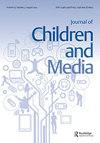United States adolescents’ responses to sexual consent on television and the moderating role of anxious attachment
IF 2.1
3区 心理学
Q2 COMMUNICATION
引用次数: 0
Abstract
ABSTRACT Understanding effects of televised depictions of sexual consent communication on adolescents is important, given that many individuals experience their first romantic and sexual relationships during this developmental period. Using the theory of planned behavior as a framework, we examined how portrayals of verbal and non-verbal sexual consent in adolescent-directed programming influenced attitudes, perceived norms, and perceived behavioral control regarding sexual consent communication among a sample of adolescents (ages 12–17, N = 130). We also examined adolescents’ anxious attachment as a moderator. Results demonstrated a significant main effect of experimental condition on sexual consent norms, but anxious attachment orientation did not moderate the relationships between experimental condition and perceived norms. We discuss findings in the context of individual differences, with implications for the design of media to support sexual consent communication among different adolescents. Impact summary Prior State of Knowledge: Sexual television content may elicit shifts in viewers’ sexual attitudes and beliefs, but few studies have examined the effects of depictions of sexual consent communication. Novel Contributions: The current study examines whether and how adolescents respond to television content about sexual consent communication, and whether those responses vary at different levels of anxious attachment. Practical Implications: This work demonstrates the need for television programmers to emphasize the importance of sexual consent communication for all types of sexual behavior. Parents and sexuality educators who work with adolescents should establish consent communication as a natural and necessary step in sexual initiation, particularly for those exhibiting low levels of consent self-efficacy.美国青少年对电视性同意的反应及焦虑依恋的调节作用
摘要了解电视对青少年性同意沟通的描述对青少年的影响很重要,因为许多人在这一发展时期经历了他们的第一次浪漫和性关系。以计划行为理论为框架,我们研究了青少年导向编程中言语和非言语性同意的描述如何影响青少年样本(12-17岁,N=130)对性同意沟通的态度、感知规范和感知行为控制。我们还研究了青少年作为调节因子的焦虑依恋。结果表明,实验条件对性同意规范有显著的主要影响,但焦虑依恋取向并不能调节实验条件与感知规范之间的关系。我们在个体差异的背景下讨论了这一发现,并对支持不同青少年性同意沟通的媒体设计产生了影响。影响总结先前的知识状态:性电视内容可能会引起观众性态度和性信仰的转变,但很少有研究考察性同意沟通描述的影响。新颖贡献:目前的研究考察了青少年是否以及如何对有关性同意沟通的电视内容做出反应,以及这些反应是否在不同程度的焦虑依恋中有所不同。实际意义:这项工作表明,电视节目制作人需要强调性同意沟通对所有类型性行为的重要性。与青少年合作的父母和性教育者应将同意沟通作为性启蒙的自然和必要步骤,特别是对于那些表现出低水平同意自我效能的人。
本文章由计算机程序翻译,如有差异,请以英文原文为准。
求助全文
约1分钟内获得全文
求助全文

 求助内容:
求助内容: 应助结果提醒方式:
应助结果提醒方式:


